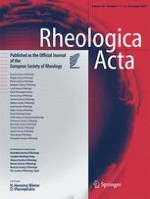01-12-2010 | Original Contribution
Extensional rheology of concentrated emulsions as probed by capillary breakup elongational rheometry (CaBER)
Published in: Rheologica Acta | Issue 11-12/2010
Log inActivate our intelligent search to find suitable subject content or patents.
Select sections of text to find matching patents with Artificial Intelligence. powered by
Select sections of text to find additional relevant content using AI-assisted search. powered by
